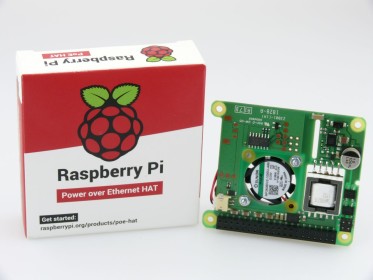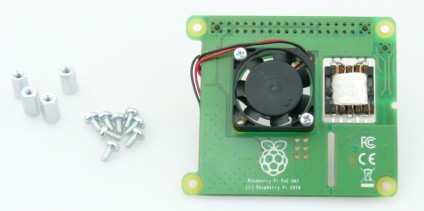Review: Raspberry Pi Power over Ethernet HAT
September 18, 2018
on
on
After a little delay the Raspberry Pi Foundation released the Power over Ethernet HAT for the Raspberry Pi 3B+ model. This can provide up to 2.5 A at 5 V to the system.
 With Power over Ethernet (PoE) a device no longer needs a separate power supply and can get its power direct from the switch, or a power injector, over the Ethernet cable. On the market you find a bunch of solutions that will provide power over Ethernet. The cheapest ones are the passive power injector systems, that reuse some of the Ethernet pairs to inject a given voltage, commonly 5, 12 or 24 Volt DC. This systems are not generally interoperable and usually only work with the gear they were specifically designed for. The other side are the PoE systems that comply to 802.3af or 802.3at. This defines a vendor independent way of delivering power to a device, and is the way the Raspberry Pi goes. Using this HAT won't be the common way of powering your Pi for a long time, but gives us some nice use cases. Everywhere you already have installed network cable you can now attach your Pi without the need of a separate power supply. This comes handy if you build something like a access point or a network powered PBX.
With Power over Ethernet (PoE) a device no longer needs a separate power supply and can get its power direct from the switch, or a power injector, over the Ethernet cable. On the market you find a bunch of solutions that will provide power over Ethernet. The cheapest ones are the passive power injector systems, that reuse some of the Ethernet pairs to inject a given voltage, commonly 5, 12 or 24 Volt DC. This systems are not generally interoperable and usually only work with the gear they were specifically designed for. The other side are the PoE systems that comply to 802.3af or 802.3at. This defines a vendor independent way of delivering power to a device, and is the way the Raspberry Pi goes. Using this HAT won't be the common way of powering your Pi for a long time, but gives us some nice use cases. Everywhere you already have installed network cable you can now attach your Pi without the need of a separate power supply. This comes handy if you build something like a access point or a network powered PBX.
 The Raspberry Pi Power over Ethernet HAT comes ready to use in a small little box, with some bolts and screws. Unlike other HATs this one doesn't allow stacking another one on top of it out of the box. It is still possible with two additional spacer to restore this kind of function, but this is not included in the box. The designer must have thought that this HAT will be the only attached to a Pi to operate it in some rougher environments, or just to put it somewhere in a remote DIN Rail enclosure.
The Raspberry Pi Power over Ethernet HAT comes ready to use in a small little box, with some bolts and screws. Unlike other HATs this one doesn't allow stacking another one on top of it out of the box. It is still possible with two additional spacer to restore this kind of function, but this is not included in the box. The designer must have thought that this HAT will be the only attached to a Pi to operate it in some rougher environments, or just to put it somewhere in a remote DIN Rail enclosure.
Before you install the HAT on top of the Pi be sure you upgraded your system to the latest version and have all updates installed. This ensures that the small fan on top of the HAT operates accordingly and kicks in as the temperature of the Pi’s CPU rises above a given level. Besides this, everything else is plug and play.
Also this issue is discussed here.
 With Power over Ethernet (PoE) a device no longer needs a separate power supply and can get its power direct from the switch, or a power injector, over the Ethernet cable. On the market you find a bunch of solutions that will provide power over Ethernet. The cheapest ones are the passive power injector systems, that reuse some of the Ethernet pairs to inject a given voltage, commonly 5, 12 or 24 Volt DC. This systems are not generally interoperable and usually only work with the gear they were specifically designed for. The other side are the PoE systems that comply to 802.3af or 802.3at. This defines a vendor independent way of delivering power to a device, and is the way the Raspberry Pi goes. Using this HAT won't be the common way of powering your Pi for a long time, but gives us some nice use cases. Everywhere you already have installed network cable you can now attach your Pi without the need of a separate power supply. This comes handy if you build something like a access point or a network powered PBX.
With Power over Ethernet (PoE) a device no longer needs a separate power supply and can get its power direct from the switch, or a power injector, over the Ethernet cable. On the market you find a bunch of solutions that will provide power over Ethernet. The cheapest ones are the passive power injector systems, that reuse some of the Ethernet pairs to inject a given voltage, commonly 5, 12 or 24 Volt DC. This systems are not generally interoperable and usually only work with the gear they were specifically designed for. The other side are the PoE systems that comply to 802.3af or 802.3at. This defines a vendor independent way of delivering power to a device, and is the way the Raspberry Pi goes. Using this HAT won't be the common way of powering your Pi for a long time, but gives us some nice use cases. Everywhere you already have installed network cable you can now attach your Pi without the need of a separate power supply. This comes handy if you build something like a access point or a network powered PBX.
What is in the box
 The Raspberry Pi Power over Ethernet HAT comes ready to use in a small little box, with some bolts and screws. Unlike other HATs this one doesn't allow stacking another one on top of it out of the box. It is still possible with two additional spacer to restore this kind of function, but this is not included in the box. The designer must have thought that this HAT will be the only attached to a Pi to operate it in some rougher environments, or just to put it somewhere in a remote DIN Rail enclosure.
The Raspberry Pi Power over Ethernet HAT comes ready to use in a small little box, with some bolts and screws. Unlike other HATs this one doesn't allow stacking another one on top of it out of the box. It is still possible with two additional spacer to restore this kind of function, but this is not included in the box. The designer must have thought that this HAT will be the only attached to a Pi to operate it in some rougher environments, or just to put it somewhere in a remote DIN Rail enclosure.Before you install the HAT on top of the Pi be sure you upgraded your system to the latest version and have all updates installed. This ensures that the small fan on top of the HAT operates accordingly and kicks in as the temperature of the Pi’s CPU rises above a given level. Besides this, everything else is plug and play.
First use problems
Now if everything is plugged in and ready, what can go wrong? Well, let us use the following setup:- A DIGITUS PoE Injector (DN-95102) for 10/100 MBit
- A Raspberry Pi 3B+
- Raspberry Pi PoE HAT
- Working Ethernet cable
- Gigabit Ethernet switch without PoE
Also this issue is discussed here.
Read full article
Hide full article



Discussion (0 comments)